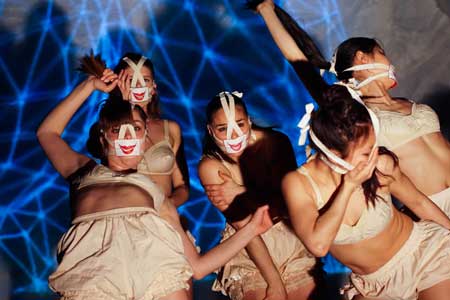Dance, Performance Art
Choreographed by DeAnna Pellechia
KAIROS Dance Theater
Boston Center for the Arts
November 15-17, 2019
With Garden of FEMME: Dev Blair, Maggie Markham, Dahlia Strack; Pole Dancers: Ashley Banx, Reina Gold; Dancers: DeAnna Pellecchia, Kristin Wagner, Robin Amylon, I.J. Chan, Maggie Markham, Yaqi Wu; Filmmaker: Lindsay Caddle Lapointe

Photo: Courtesy of KAIROS Dance Theater
KAIROS is passionate about its mission and its performers exhibit a gusto that conforms to that sense of mission. Here the subject is the objectification of women, hence the overtones of the title of the piece. But the title Object., with a period, also represents an imperative verb not a noun. That title’s double significance, then, stands for both the subject of objectification, and, as well, an encouragement for women to take up arms against that objectification.
There is a lot of irony in this performance and one needs to get with the program in order to get the best sense of what this piece is about and the manner in which its stance is being presented.
The performance begins with a preamble, including two women who do a series of pole dances. Their acrobatics are admirable and they bring an athletic dimension to the performance overall. Interestingly, pole dancing, as well as an art form on its own terms, is frequently associated with female performers in strip clubs, so its inclusion in this very self-conscious performance about such framing of women conveys a double purpose – to demonstrate the beauty of the performances themselves and to highlight the way in which such performances serve to demean women. That double intent makes the reception of the pole performances complicated indeed. And that kind of complexity and irony dominates the performance throughout.
The dance performance proper features six dancers in a series of different segments, some of which feature them dancing in very high heeled shoes, sometimes with one thrown off. As well, there are segments in which these dancers don face masks that have a Kabuki-like feel to them, each plastered with ruby lips puckered over the obscured face of each dancer. In keeping with the ironies, as well, the dancers all appear in underwear – brassieres and frilly long underwear-leggings.
Some of the dancers move beautifully, and there are some sequences that enable such grace to come through. In other places, the movements are intentionally jerky and disruptive, giving the sense that more movement-oriented choreographic choices frequently yield to more polemical ends germane to a performance piece.
Tthere are some video pieces integrated with the dance, showing, notably, a stream of admirable women. But there are also grab-bags of images, some from the deep past, seemingly intended to set an historical tone to the narrative.
This is not “ordinary” choreography which devotes its foremost concerns to gestural harmony and variation in the more conventional ways. Repetition of almost a minimalist sort prevails here rather than that kind of nuanced variation. There are indeed new moments and new symbols introduced throughout, but done so more as a dialectical reminder of the piece’s argumentative intent than as specifically attentive to the evolution of movement itself.
– BADMan (aka Charles Munitz)
Leave a Reply